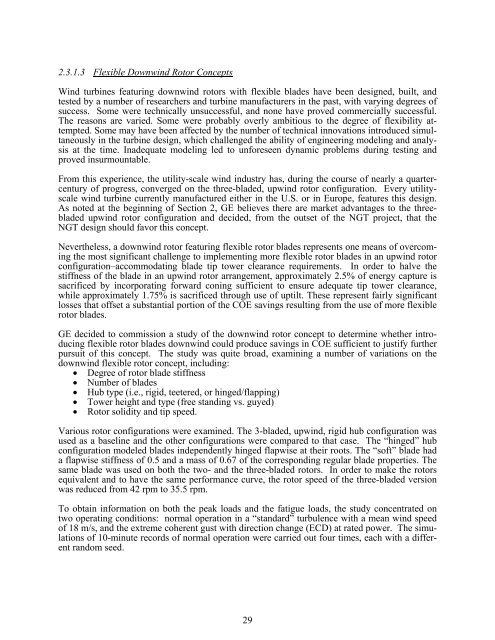Advanced Wind Turbine Program Next Generation Turbine ... - NREL
Advanced Wind Turbine Program Next Generation Turbine ... - NREL
Advanced Wind Turbine Program Next Generation Turbine ... - NREL
Create successful ePaper yourself
Turn your PDF publications into a flip-book with our unique Google optimized e-Paper software.
2.3.1.3 Flexible Downwind Rotor Concepts<br />
<strong>Wind</strong> turbines featuring downwind rotors with flexible blades have been designed, built, and<br />
tested by a number of researchers and turbine manufacturers in the past, with varying degrees of<br />
success. Some were technically unsuccessful, and none have proved commercially successful.<br />
The reasons are varied. Some were probably overly ambitious to the degree of flexibility attempted.<br />
Some may have been affected by the number of technical innovations introduced simultaneously<br />
in the turbine design, which challenged the ability of engineering modeling and analysis<br />
at the time. Inadequate modeling led to unforeseen dynamic problems during testing and<br />
proved insurmountable.<br />
From this experience, the utility-scale wind industry has, during the course of nearly a quartercentury<br />
of progress, converged on the three-bladed, upwind rotor configuration. Every utilityscale<br />
wind turbine currently manufactured either in the U.S. or in Europe, features this design.<br />
As noted at the beginning of Section 2, GE believes there are market advantages to the threebladed<br />
upwind rotor configuration and decided, from the outset of the NGT project, that the<br />
NGT design should favor this concept.<br />
Nevertheless, a downwind rotor featuring flexible rotor blades represents one means of overcoming<br />
the most significant challenge to implementing more flexible rotor blades in an upwind rotor<br />
configuration–accommodating blade tip tower clearance requirements. In order to halve the<br />
stiffness of the blade in an upwind rotor arrangement, approximately 2.5% of energy capture is<br />
sacrificed by incorporating forward coning sufficient to ensure adequate tip tower clearance,<br />
while approximately 1.75% is sacrificed through use of uptilt. These represent fairly significant<br />
losses that offset a substantial portion of the COE savings resulting from the use of more flexible<br />
rotor blades.<br />
GE decided to commission a study of the downwind rotor concept to determine whether introducing<br />
flexible rotor blades downwind could produce savings in COE sufficient to justify further<br />
pursuit of this concept. The study was quite broad, examining a number of variations on the<br />
downwind flexible rotor concept, including:<br />
• Degree of rotor blade stiffness<br />
• Number of blades<br />
• Hub type (i.e., rigid, teetered, or hinged/flapping)<br />
• Tower height and type (free standing vs. guyed)<br />
• Rotor solidity and tip speed.<br />
Various rotor configurations were examined. The 3-bladed, upwind, rigid hub configuration was<br />
used as a baseline and the other configurations were compared to that case. The “hinged” hub<br />
configuration modeled blades independently hinged flapwise at their roots. The “soft” blade had<br />
a flapwise stiffness of 0.5 and a mass of 0.67 of the corresponding regular blade properties. The<br />
same blade was used on both the two- and the three-bladed rotors. In order to make the rotors<br />
equivalent and to have the same performance curve, the rotor speed of the three-bladed version<br />
was reduced from 42 rpm to 35.5 rpm.<br />
To obtain information on both the peak loads and the fatigue loads, the study concentrated on<br />
two operating conditions: normal operation in a “standard” turbulence with a mean wind speed<br />
of 18 m/s, and the extreme coherent gust with direction change (ECD) at rated power. The simulations<br />
of 10-minute records of normal operation were carried out four times, each with a different<br />
random seed.<br />
29
















